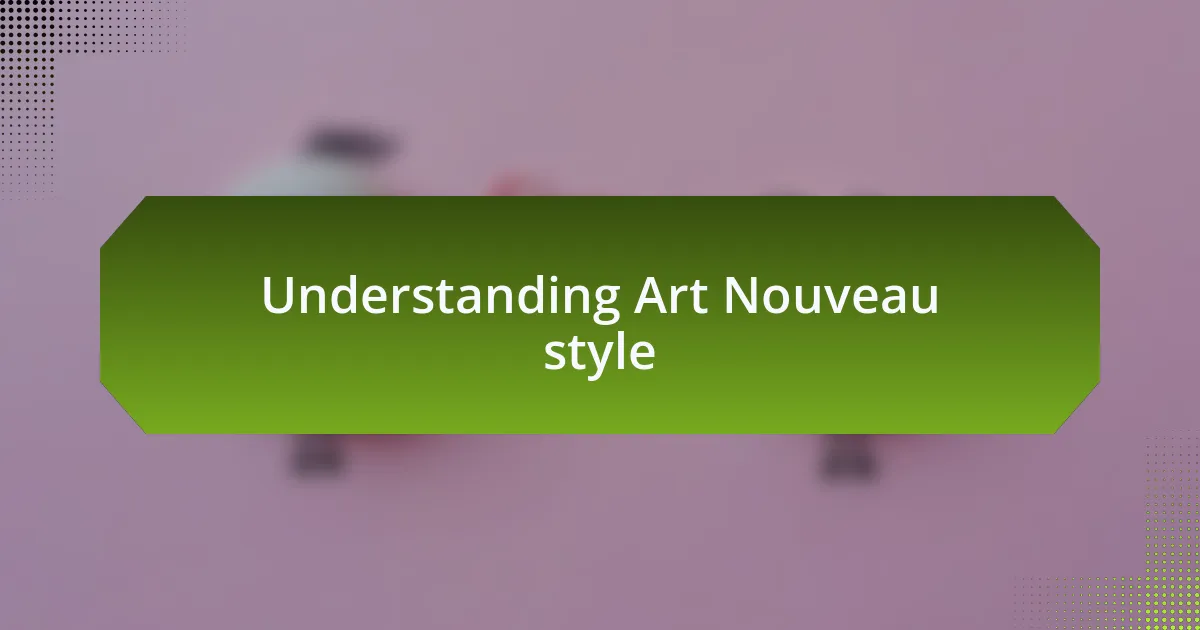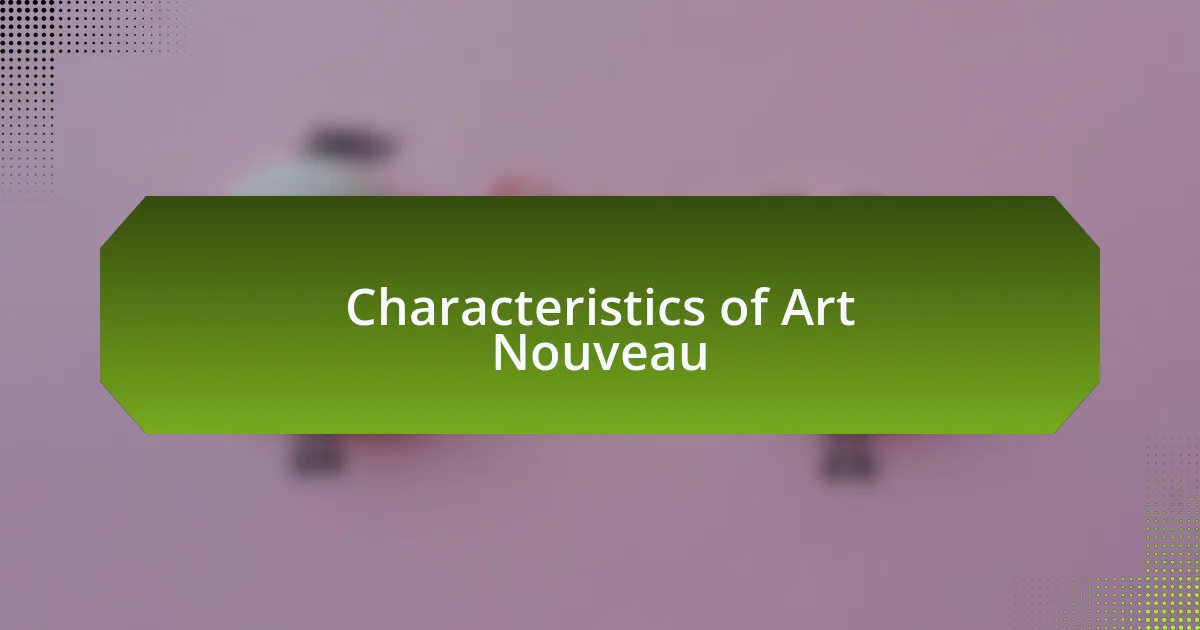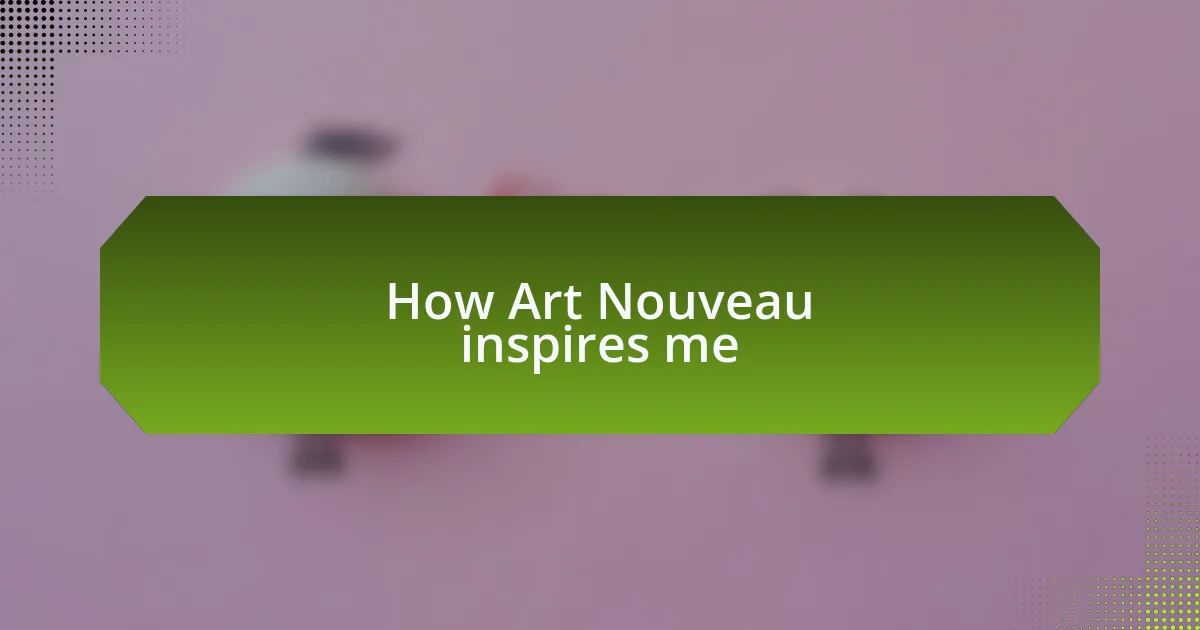Key takeaways:
- Art Nouveau emerged as a response to the rigid academic norms of the late 19th and early 20th centuries, emphasizing natural forms and craftsmanship.
- Key artists like Alphonse Mucha, Gustav Klimt, and Antoni Gaudí significantly influenced the movement, each contributing unique elements that celebrated the connection between art and nature.
- The movement is characterized by intricate design, holistic creative expressions, and deeper meanings conveyed through motifs, reflecting societal views and emotions.

Understanding Art Nouveau style
Art Nouveau emerged in the late 19th and early 20th centuries as a reaction against the rigid academic norms of the time. I remember walking through an old town and being captivated by the flowing lines and organic shapes typical of this style. It was as if the buildings themselves were alive, each curve telling a story that echoed nature’s beauty.
What strikes me most about Art Nouveau is its commitment to harmony and craftsmanship. Every piece, from architecture to decorative arts, feels intentional and profoundly connected to the natural world. Have you ever paused to appreciate how a simple wrought-iron railing can morph into a delicate vine, inviting you to touch and explore?
In my experience, the emotional impact of Art Nouveau is undeniable. Its intricate designs and soft, flowing forms evoke a sense of whimsy and wonder, transporting you to a different time and place. For me, this style teaches us that art can be both functional and a feast for the senses, bridging the gap between everyday life and extraordinary creativity.

Characteristics of Art Nouveau
The defining characteristic of Art Nouveau is undoubtedly its emphasis on natural forms and organic lines. I recall visiting a gallery where the intricate floral motifs intertwined seamlessly in the design, creating a sense of flowing movement that seemed almost magical. It makes me ponder, how can something so visually captivating resonate so deeply with our innate connection to nature?
Moreover, craftsmanship plays a pivotal role in Art Nouveau’s aesthetic. The attention to detail in each piece is remarkable—they often feature hand-worked materials like glass and wrought iron that highlight the artist’s dedication. I once held a delicately crafted glass vase that felt alive with swirling colors, and it struck me how this level of artistry could transform an everyday object into a cherished treasure.
Finally, Art Nouveau embraces a holistic approach, aiming to unify different art forms. It’s fascinating to see how architecture, furniture, and decorative arts harmoniously blend to create an immersive experience. Have you stepped into an Art Nouveau space and felt completely enveloped by the environment? For me, it emphasizes the understanding that art is not just to be seen but also to be experienced and felt, allowing us to engage with our surroundings in a new, enriching way.

History of Art Nouveau movement
The Art Nouveau movement emerged in the late 19th century, blossoming in response to the industrial age’s mechanization. I remember reading about its beginnings in Europe, particularly in cities like Paris and Brussels, where artists sought to break away from the rigid styles of the time. Isn’t it intriguing how a new appreciation for craftsmanship and nature can arise from the tensions created by rapid industrialization?
As the movement gained momentum, it embraced a myriad of disciplines—architecture, design, and fine arts—all striving for a cohesive aesthetic. I can’t help but think about the first time I encountered the iconic architecture of Victor Horta, whose curved lines and delicate designs felt like they breathed life into buildings. It’s fascinating how the intricate details embody a deeper philosophy, reflecting a desire to return to the beauty of the natural world.
By the early 20th century, Art Nouveau reached its zenith before gradually fading, giving way to modern movements. Reflecting on its legacy, I often wonder how such a unique blend of art and nature has continued to inspire contemporary artists today. Don’t you find it remarkable how the ethos of Art Nouveau lingers, urging us to look for beauty and harmony in our daily lives?

Influential artists in Art Nouveau
Alphonse Mucha is often celebrated as one of the most influential artists of the Art Nouveau movement, primarily known for his stunning posters that captured the essence of the era. When I first saw Mucha’s work, I was struck by the intricate patterns and flowing lines that seemed to swirl around his subjects, almost as if they were part of a larger natural world. Isn’t it fascinating how his art not only popularized a style but also conveyed a narrative quality that spoke to the spirit of his time?
Another key figure, Gustav Klimt, contributed significantly to the movement with his unique approach to painting. His use of gold leaf and ornate designs creates a luxurious richness that I find both captivating and emotional. I remember standing before his famous piece, “The Kiss,” feeling overwhelmed by how it celebrates intimacy and connection, evoking a profound sense of vulnerability and beauty. The way Klimt intertwined figures with decorative elements creates a dreamlike aura—don’t you think that this blending of styles invites viewers into a deeper emotional experience?
Finally, I believe that Antoni Gaudí deserves mention as an artist whose innovative architectural designs pushed the boundaries of Art Nouveau. Visiting the Sagrada Família was a transformative experience for me; the organic forms and playful colors feel as if they sprang directly from nature. Gaudí’s vision truly embodies the Art Nouveau ethos, reflecting an intricate relationship between structure and the environment, don’t you agree that nature and architecture can coalesce in such a harmonious dance?

Key elements I appreciate
One key element I appreciate in Art Nouveau is the emphasis on organic forms. I can’t help but marvel at the way artists often drew inspiration from nature, weaving floral and curvilinear designs into their work. The moment I first encountered a stained glass window adorned with sinuous lines and botanical motifs, it felt like stepping into a lush garden; you can almost hear the gentle rustle of leaves. Don’t you think this connection to the natural world adds a layer of serenity to the art?
Another aspect I find intriguing is the intricate craftsmanship prevalent in this movement. I vividly recall visiting a jewelry exhibition showcasing pieces by René Lalique; each creation was a testament to meticulous artistry. The delicate details in the designs made me feel as if I were holding a piece of nature in my hands. Isn’t it remarkable how such dedication to craft can evoke emotions and create a deeper appreciation for the objects we often take for granted?
Lastly, I admire the symbolic nature of Art Nouveau. This style often conveys deeper meanings through its motifs and designs. I was particularly moved while examining works that incorporated the female form as a symbol of nature and vitality. It struck me that these representations held a mirror to society’s views on femininity during the era. I find myself pondering how art can reflect and reshape cultural narratives—what do you think about the power of symbolism in art?

My favorite Art Nouveau pieces
One of my favorite Art Nouveau pieces has to be Alphonse Mucha’s “The Seasons” series. The first time I laid eyes on these stunning panels, I was struck by the ethereal beauty of the figures, each representing a different season with flowing robes and intricate floral details. I still remember the feeling of standing in front of them, completely captivated; it was as if the very essence of nature was dancing before my eyes. Don’t you think the way Mucha encapsulates the changing seasons is a reminder of the cycles of life?
Another remarkable piece that has left a lasting impression on me is Gustav Klimt’s “The Kiss.” The lush patterns and rich gold elements seem to envelop the viewer in a warm embrace. I can almost recall the electric atmosphere in the room when I first experienced it at the museum, my heartbeat quickening as I took in the intimate moment portrayed. Have you ever felt that the connection between the lovers in this piece transcends time, making you reflect on your own relationships?
I also cherish the works of Louis Comfort Tiffany, particularly his stunning stained glass lamps. The intricate glass pieces create an enchanting play of light that transforms any space. I remember sitting in my living room, bathed in the colorful glow of a Tiffany lamp, feeling a sense of peace wash over me. It’s fascinating how a simple object can evoke such a myriad of emotions, isn’t it? Each piece tells a story, and I often find myself wondering about the history behind these creations and the hands that crafted them.

How Art Nouveau inspires me
Art Nouveau resonates deeply with me not only for its aesthetic beauty but also for the philosophy it embodies. I often find inspiration in the organic forms and natural motifs that characterize the movement. For instance, during a visit to an Art Nouveau exhibit, I felt as though I was transported to a world where nature and art were intertwined, weaving a narrative that celebrates life and beauty. Isn’t it fascinating how those designs invite us to slow down and appreciate every detail around us?
What truly inspires me about Art Nouveau is its emphasis on craftsmanship and the idea of artistry as a holistic experience. I once tried my hand at creating a piece inspired by this style, and I was overwhelmed by the joy of working with my hands to bring a vision to life. The process taught me that art is not just the final product but also the passion and intention poured into every stroke and curve. Have you ever experienced that sense of fulfillment when creating something by hand?
Moreover, the emotional depth found in Art Nouveau pieces keeps me coming back to them. I recall a quiet evening where I sat with a book on Art Nouveau, surrounded by stunning illustrations of its works. Each image sparked a wave of creativity in me, reminding me that art has the power to evoke feelings and thoughts that often remain unspoken. Don’t you think that art, in any form, serves as a mirror to our emotions and experiences?